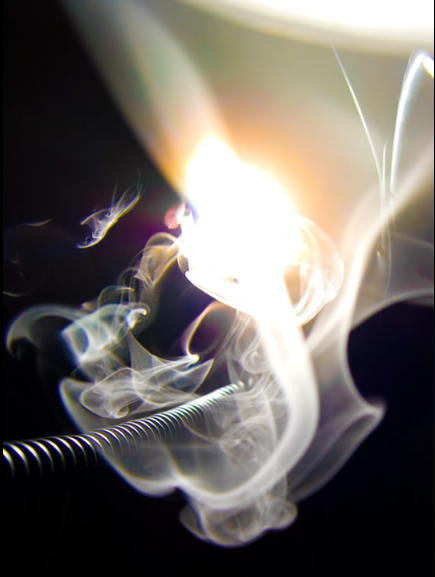Household Iridescence
Household Iridescence: Unveiling the Colors in Mist from a Humidifier
Have you ever marveled at the vibrant colors dancing within the mist emitted by a decorative humidifier? This mesmerizing phenomenon, known as household iridescence, captivates our imagination and sparks curiosity about the science behind it. In this article, we will delve into the intricate details of this captivating optical display and explore the factors that contribute to its enchanting beauty.
The iridescent colors and corona ring observed in the mist arise from the scattering of light by individual droplets. As the strobe light passes through the mist, it interacts with the droplets, causing them to scatter the light and form an angular diffraction pattern. When the droplets are of similar size, as seen in decorative humidifiers, their individual diffraction patterns align, resulting in the vivid display of iridescent colors. On the other hand, when droplets of different sizes are present, their patterns overlap, leading to the formation of white or pastel hues.
To witness the most remarkable iridescence, one must find atmospheric conditions where the droplets have all formed around the same time and have not yet undergone significant size distribution evolution. Such conditions can be found in various natural and artificial settings, including pileus clouds, lenticular clouds, aircraft wakes, subliming frost, and, intriguingly, decorative humidifiers.
Pileus clouds, often referred to as "cap clouds," are a type of cloud that forms above cumulus clouds when there is an upward motion of moist air. These clouds possess a unique structure, with droplets forming simultaneously and maintaining a relatively uniform size distribution. This combination of factors creates an ideal environment for breathtaking iridescence to occur.
Lenticular clouds, commonly observed near mountainous regions, are another atmospheric phenomenon that can exhibit remarkable iridescence. These lens-shaped clouds form when moist air flows over mountains, creating a series of standing waves in the atmosphere. Within these clouds, the droplets form under conditions similar to pileus clouds, offering an opportunity for vibrant colors to emerge.
Aircraft wakes, the trails left behind by airplanes, also provide an intriguing canvas for household iridescence. As an aircraft moves through the air, it disturbs the surrounding moisture, causing the formation of tiny water droplets. These droplets, still in their nascent stage and relatively uniform in size, scatter light to create stunning displays of iridescent hues.
In addition to natural occurrences, decorative humidifiers can also generate captivating iridescence within our homes. These devices utilize ultrasonic technology to create a homogeneous mist composed of droplets of similar size. As the strobe light interacts with these droplets, the diffraction patterns align, resulting in the vivid display of colors that captivate our senses.
Understanding the science behind household iridescence allows us to appreciate the beauty of this optical phenomenon even further. The alignment of diffraction patterns in droplets of similar size is responsible for the vibrant colors we observe. Conversely, the overlap of patterns in dissimilar droplets leads to the formation of softer hues or white. By exploring different atmospheric conditions and artificial settings, we can witness this captivating display of color and gain a deeper appreciation for the wonders of our natural and manufactured environments.
Next time you encounter the enchanting mist from a decorative humidifier or witness iridescence in the sky, take a moment to marvel at the intricate interplay of light and water droplets that creates such a breathtaking spectacle. The world around us is filled with hidden wonders waiting to be discovered, and household iridescence is just one of many captivating phenomena that remind us of the awe-inspiring beauty of our planet.

Household Iridescence - colours in mist from a humidifier by Tim Stone (images). ©Tim Stone, shown with permission.
"I took this picture while experimenting with strobing my decorative humidifier. It creates a nicely homogeneous mist using ultrasonics."
The iridescent colours and corona ring come from individual droplets scattering the strobe light to form an angular diffraction pattern. When the droplets are similar sized - as here - their individual patterns are the same and we see the colours. Patterns from dissimilar particles overlap to produce white or at most rather pastel hues. Thus the best iridescence comes from clouds where droplets have all formed more or less at the same time and are still sufficiently 'young' that their size distribution has not evolved and broadened.
Find these conditions in pileus cloud, lenticular clouds, aircraft wakes, subliming frost and.. ..decorative humidifiers.
Note: this article has been automatically converted from the old site and may not appear as intended. You can find the original article here.
Reference Atmospheric Optics
If you use any of the definitions, information, or data presented on Atmospheric Optics, please copy the link or reference below to properly credit us as the reference source. Thank you!
-
<a href="https://atoptics.co.uk/blog/household-iridescence/">Household Iridescence</a>
-
"Household Iridescence". Atmospheric Optics. Accessed on April 20, 2024. https://atoptics.co.uk/blog/household-iridescence/.
-
"Household Iridescence". Atmospheric Optics, https://atoptics.co.uk/blog/household-iridescence/. Accessed 20 April, 2024
-
Household Iridescence. Atmospheric Optics. Retrieved from https://atoptics.co.uk/blog/household-iridescence/.